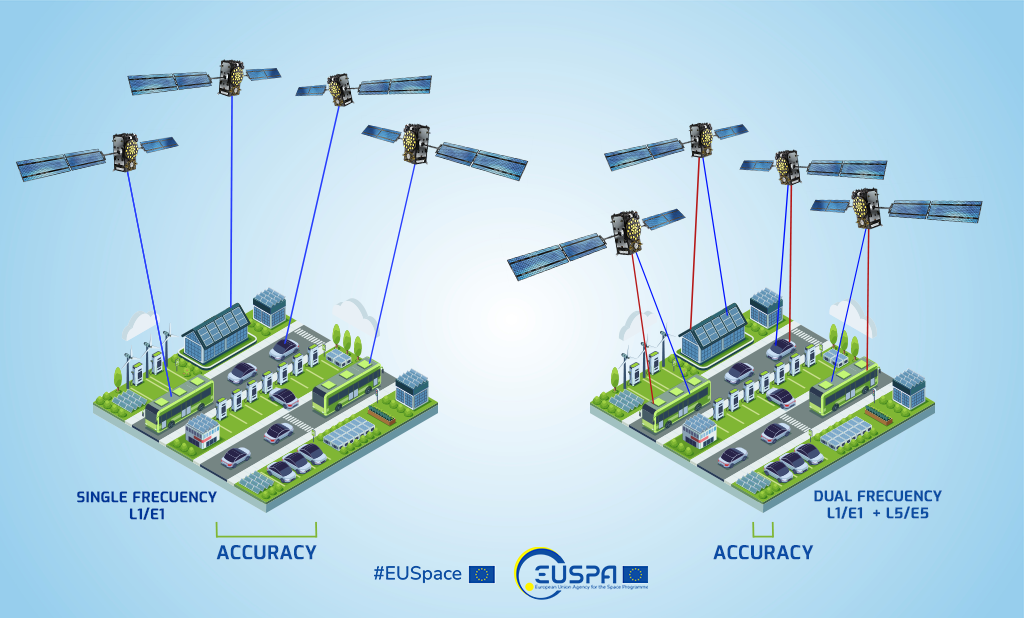Test your device’s satellite navigation performance!

As Galileo is integrated directly into the smartphone hardware, your phone needs a chip that can track Galileo signals to be compatible. Fortunately, most modern smartphone chips support multiple Global Navigation Satellite Systems (GNSS), meaning they can use data from various constellations. The key is to know which constellations your phone is actually using. Manufacturers like Broadcom, Qualcomm, Intel, and Mediatek continue to integrate Galileo into their chips, which are used in many leading smartphones.
Android users have a range of applications, many of them free, to determine if their phone is currently utilizing Galileo, GPS, or GLONASS satellites for positioning. Here is a list of apps that will help you to check GNSS performance:
- GPSTest: This open-source app displays real-time information about the satellites your device is communicating with, including GPS (indicated by the American flag), Galileo (EU flag), GLONASS (Russian flag), and BeiDou (Chinese flag), as well as regional systems like QZSS (Japanese flag) and others. If a Galileo satellite has a 'U' next to it on the status screen, your device is actively using it for positioning. You can download it from the Google Play Store or F-Droid.
- GNSSLogger: It is a tool designed to record raw GNSS measurements from Android devices. Essentially, it allows developers and researchers to collect detailed data (navigation message, pseudoranges, carrier phase...), directly from the phone's GPS, Galileo, GLONASS, BeiDou, and other satellite receivers. The app itself primarily focuses on the collection of this detailed GNSS data for later analysis with other tools, such as the GNSS Analysis app (it reads the GNSS raw measurements collected and uses them to analyze the GNSS receiver behavior; more information on this app can be found here). You can download it from the Google Play Store.
- GNSS Status (GPS Test): This app provides comprehensive information about all GNSS supported by your device, including GPS, GLONASS, Galileo, and BeiDou. It shows satellite locations, signal strength, and can display GPX files with various map services. You can download it from the Google Play Store.
- GalileoPVT: Developed as an unofficial project by engineers at the European Space Agency, this app visualizes Galileo satellite navigation signals. For compatible devices, it uses raw signals from Galileo satellites to calculate your position independently and compares it with GPS and the internal Android location. It also features an augmented reality view to see where Galileo satellites are in the sky. You can download it from the Google Play Store.
- GNSSTest: This professional app, designed for testers, supports various constellations, including GPS (L1/L5), Glonass, QZSS (L1/L5), BeiDou, Galileo (E1/E5), and NavIC (L5). It offers features for functional and performance testing, NMEA and raw data recording, and CEP (Circular Error Probability) calculation. You can download it from Aptoide.
- GNSS Viewer: This app essentially lets you see and understand the satellites that your phone (or other GNSS-enabled device) uses to determine its location. It shows where the GPS, GLONASS, Galileo, BeiDou and QZSS satellites are in the sky right now (or at a specific time). In addition, it tells users which specific satellites the device is currently using, it gives information about the accuracy of the device location based on the positions of these satellites and allows users to filter which satellites they want to see (e.g., only GPS satellites). You can download it from the Google Play Store.
It has to be noted that iOS apps don't offer a public library for developers to create their own apps and read the raw data coming from GNSS. On iOS, it’s not possible to know where the position comes from or how it's calculated. An APP available and trustworthy both for IOS and Apple is the following:
- GNSS view: The GNSS View app allows users to visualize the Quasi-Zenith Satellite System (QZSS) and other positioning satellites like GPS in the sky at a specific time and location. It offers a Position Radar screen and an AR Display screen to view satellites, allowing users to specify satellites, signals, and elevation mask angles. The app does not collect any user data. You can download it from the App Store. It’s also available for Android, from the Google Play Store. The Android version of GNSS View provides a radar view and an augmented reality view of positioning satellites such as QZSS, GPS, GLONASS, BeiDou, Galileo, and SBAS at a specified time and location. The satellite positions are calculated based on publicly released orbit information, not directly from the phone's receiver. You can specify which satellite systems and signals to view.
Keep exploring these apps to observe how Galileo improves your phone's location accuracy!!
About Galileo
Galileo, the EU´s Global Navigation Satellite System (GNSS), provides improved navigation, positioning and timing information. More than 4 billion users are already benefitting from Galileo.
The Galileo Programme is owned by the EU. The European Commission, as the Programme Manager, oversees the implementation of all activities. EUSPA is responsible for the operational management of the services, ensuring that they are delivered with the defined performance and without interruption. Galileo's system design and system evolution are entrusted by EUSPA to ESA .
Media note: This feature can be republished without charge provided the European Union Agency for the Space Programme (EUSPA) is acknowledged as the source at the top or the bottom of the story. You must request permission before you use any of the photographs on the site. If you republish, we would be grateful if you could link back to the EUSPA website.